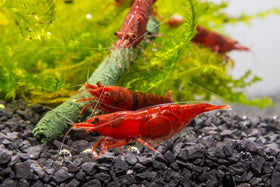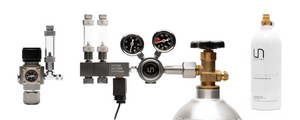
Top 10 Aquascaping Myths
Written By: Chris (@shrimpery)
Most hobbies are either artistic (like painting) or scientific (home beer brewing). Aquascaping is a relatively unique hobby: a good scape requires both a strong aesthetic sensibility and a decent understanding of how to apply scientific concepts. It is difficult to create a pristine planted aquascape if you do not understand pH, lighting, water hardness, and bacterial cycling. However, if you only understand the scientific side of things but lack good taste, you will have beautiful plants inhabiting an ugly and unbalanced layout. There are many excellent resources that aspiring hobbyists can use to build their skill and knowledge base, but there is also quite a bit of misinformation floating around on the internet to lead new hobbyists astray. While some of the misinformation involves unnecessary but benign advice, the rest of it could potentially prevent your tank from reaching its fullest potential.

Here are my top 10 myths about aquascaping:
1. Myth: Sunlight causes algae.
Algae and plants require sunlight to grow, and both will grow more vigorously in brighter conditions. But because both aquatic plants and algae also need nutrients to survive, and because true plants will always outcompete algae if sufficient plant mass is present, sunlight only causes algae if excess nutrients are present or if there is inadequate plant mass. When people refer to algae breakouts occurring due to an “imbalance” in the tank, the true subtext is that something is causing a nutrient imbalance (with an undersized filter, excessive fertilizer, overfeeding, inadequate plant mass, overstocked, infrequent water changes being the most common culprits). There are many aquarists with spotless tanks that receive direct sunlight.
2. Myth: A heavily planted tank does not require water changes.
In a low-tech planted tank that has a small biomass and adequate filtration, it is possible to go long periods without a water change (a month or more). Just because this is possible, doesn’t mean it’s ideal, however. Due to the relative small volume of any home aquarium, breakdown of organic material results in wastes that inevitably accumulate in the water column. Add fish or other livestock, and the waste greatly compounds in the closed system of the aquarium. In a high-tech planted tank (injected CO2) with fertilizer supplementation, water changes are especially important to avoid the buildup of algae. In particular, blackbeard algae and hair algae seem to thrive best in “dirtier” tanks.
- Note: Buce Plant recommends performing weekly water changes. Click here to learn more about the importance of water changes.

3. Myth: A siesta (break in the middle of your photoperiod) will combat algae.
An old-school tip for fighting algae is to build in a “naptime” into the middle of your timer schedule. While this won’t harm your aquatic plants, it won’t harm the algae either. It may throw off the circadian rhythms of the fish in the tank, however.
4. Myth: Stem plants must be planted slightly apart from each other, so they don’t “shade each other out.”
As I mentioned in a previous blog post, it is actually best to plant your aquatic stem plants closely together, with each stem only being a few cm from each other. With most commonly used lighting fixtures, enough light will usually be able to penetrate for the bottom stems to remain healthy, and the stems will not break down if there is adequate flow in the tank. When and if the stems do become stringy and “worn out,” it is more typically the result of the stems’ advanced age or adapting to new water conditions (such as when more sensitive plants are added to a new scape) .
.
5. Myth: You need to dose extra iron to get plants to turn red.
In fact, how red a plant becomes is more a function of how much light it is received (the red pigment acts as a type of sunscreen) as well as the plant variety (some aquatic plants have more potential to become red than others).
6. Myth: A “clean-up crew” will take care of your algae problem.
Many people will purchase algae eating fish or Amano shrimp with the idea that these creatures will be conscripted into eliminating an algae breakout. While they can certainly help, algae eaters will not put much of a dent into a serious breakout. It is better to correct the underlying cause of the algae breakout (typically excess nutrients or organic wastes), rather than simply treating a symptom of the problem.

7. Myth: Your layout must adhere to the rule of thirds to be attractive.
Without getting too granular, the rule of thirds is a set of compositional suggestions intended to help frame an image or design into an aesthetically pleasing layout. While it’s a good framework to keep in mind, especially when you first begin scaping, there are numerous other ways to create an exciting and beautiful aquascape- don’t let anyone tell you otherwise!
8. Myth: CO2 is confusing and expensive to run on a tank.
Don’t get fooled by the elaborate and detailed CO2 guidelines you may see on some forum posts- it’s actually very simple and straightforward! There are plenty of affordable diffusers that can be screwed onto an inexpensive CO2 tank, set on a timer, and essentially forgotten until the tank runs out of gas. When that happens, refills of CO2 are typically available for purchase at sporting goods stores or welding shops, often at extremely cheap prices.

9. Myth: Aquascaping is a time-consuming hobby.
In fact, once a planted tank is set up and established, it is possible to spend as little as fifteen minutes a week (or even less) maintaining it. Still, once you really get into the hobby, the time spent performing maintenance is often an interesting and relaxing experience, not a chore!
10. Myth: Fish need to be fed every day.
In a high tech aquascape, it is especially important to keep excess nutrients and organic wastes to a minimum. As many veteran fishkeepers can attest, many common aquarium fish need less food than you might expect based on their behavior. I typically feed my fish a set amount every other day, and I watch them eat all of it. If you overfeed, it can shorten the fish’s lifespan and add excessive nutrients to the tank, encouraging the growth of algae.

There are plenty of other myths out there to explore, but I thought that these eight were some of the most common or egregious. Just remember, although there is some incorrect information out there, there is also no “one right way” of doing things. Aquascaping is what you make of it!
Tell us - Was this article helpful? Please leave a comment below!
If you have any questions regarding this article, please DM us on Instagram, Facebook, or email support@buceplant.com so we can assist you - @buceplant





Comments
Leave a comment